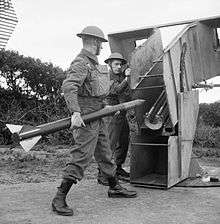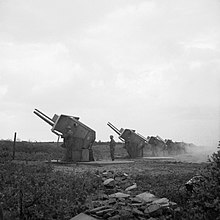Z Battery
The Z Battery was a short range anti-aircraft weapon system, which launched 3-inch (76 mm) diameter rockets from ground-based single and multiple launchers, for the air defence of the United Kingdom in World War II.


Development
The solid-fuel 3 inch (76 mm) rocket used by the Z Batteries was known as the UP-3 and had been developed in the late 1930s by the Projectile Development Establishment at Fort Halstead in Kent under the direction of Alwyn Crow[1] and was related to the Royal Navy's 7 inch (178 mm) Unrotated Projectile. The naval weapon had been enthusiastically backed by Winston Churchill when he was First Lord of the Admiralty at the outbreak of war. By June 1940, Churchill was Prime Minister and he requested "large supplies of [rocket] projectors" for the anti-aircraft defence of the mainland. The development of all British rockets was under the control of Professor F A Lindemann and he enthusiastically backed Churchill's suggestion. The naval weapon was intended to bring down low flying aircraft with a trailing wire to the end of which was attached an explosive mine; however, the land based system was intended to have a high explosive warhead, detonated by a specially designed photoelectric proximity fuse. The rocket itself was propelled by special solvent-free cordite, which was initially manufactured at Bishopton in Scotland; in December 1940, a new propellant factory was commissioned at Ranskill, which was in production by the start of 1942.[2] The metal working firm G. A. Harvey and Co of Greenwich was given the contract to manufacture the rocket bodies and over 1,000 had been made by September 1940.[3]
In October 1940, an experimental Z Battery became operational at Cardiff in South Wales under the command of Major Duncan Sandys, Churchill's son-in-law. Trials against a radio controlled Queen Bee target aircraft were successful, although the Director of Artillery at the Ministry of Supply suspected that the results were "fixed". Despite this Churchill and Lindemann drove the project forward, and by 1942, 2.4 million rockets were being produced annually.[4]
Service

The first Z Batteries were equipped with a single-rocket launcher, the Projector, 3-inch, Mark 1.[5] It was soon found that the rockets did not perform as accurately as the trials had suggested and that the proximity fuses were rarely effective.[6] Therefore, the technique of firing the rockets in large salvos was introduced, and projectors capable of firing an ever-larger number of rockets were developed. The Projector, 3-inch, No 2, Mk 1 was a twin launcher and the No 4 Mk 1 and Mk 2 fired 36 rockets at a time in a "ripple" firing sequence.[5]
During the Battle of Britain in an attack on RAF Kenley by Dornier 17 bombers, AC2 David Roberts, RAF Regiment, downed one of the two attacking aircraft destroyed using the RAF's newest anti-aircraft weapon, a line of twenty-five rockets that deployed a barrage of 500 foot cables suspended by parachutes. This weapon - the naval version of the Z Barrage - was symptomatic of the hodge-podge of weapons issued to the RAF Regiment in the early war years,[7] The other Dornier 17 was shot down by Corporal John Miller of the Scots Guards, using a Lewis gun. For this action both men received the Military Medal.
From early 1942, the manning of Z Batteries began to be transferred to the Home Guard, as the equipment was comparatively simple to operate and the rounds were lighter. (The age limit for Home Guardsmen to work on Z Batteries was 60, whereas it was 40 for those posted to conventional anti-aircraft guns and coast defence batteries, because of the heavier ammunition.)[8]
Use as a ground attack weapon
Both the No 2 and No 4 projectors were used in the North African Campaign, mounted on converted 3-inch AA gun trailers.[5] The emergency use of a No 4 projector against an enemy infantry attack in that theatre provided the inspiration for the No 8 Projector, better known as the "Land Mattress", a surface-to-surface rocket system, used in action by the Canadian Army in 1945.[9]
The UP-3 rocket was also developed into the RP-3 air-to-ground anti-tank rocket.[10]
Bethnal Green disaster
On 3 March 1943, civilians queueing to enter Bethnal Green Underground station in East London, which was being used at night as an air raid shelter, were panicked by the noise of a newly installed Z Battery firing in nearby Victoria Park. After somebody tripped on the stairs leading down to the ticket office, some three hundred people were crushed in the stairwell. 173 were killed and 90 needed hospital treatment.[11]
See also
- AA Mine Discharger, a Japanese anti-aircraft mortar.
- Holman Projector, a steam-powered anti-aircraft grenade launcher.
- Henschel Hs 297 / 7.3 cm Föhn-Gerät, a German anti-aircraft rocket system.
References
- Cocroft, Wayne D (2010). "FORT HALSTEAD, DUNTON GREEN, SEVENOAKS, KENT: A brief assessment of the role of Fort Halstead in Britain's early rocket programmes and the atomic bomb project" (PDF). english-heritage.org.uk. English Heritage. Retrieved 7 November 2014.
- Edgerton, David (2012), Britain's War Machine: Weapons, Resources, and Experts in the Second World War Penguin Books, ISBN 978-0141026107 (pp.108-110)
- Trueman, Chris. "Britain and Rocket Technology". www.historylearningsite.co.uk. Retrieved 7 November 2014.
- Edgerton p. 11
- Bishop, Chris (2002), The Encyclopedia of Weapons of World War II, Metrobooks, p. 176, ISBN 978-1586637620
- Edgerton p. 10
- Oliver, Kingsley (2002). The RAF Regiment at War. Pen & Sword. p. 5. ISBN 0-85052-852-6.
- Longmate, Norman (1974). The Real Dad's Army: The Story of the Home Guard. Amberley Publishing. ISBN 978-1-84868-914-5. (Chapter 6)
- Lucas, Andrew J (7 March 2013). "The Land Mattress: Canadian Ingenuity Takes Flight". www.flamesofwar.com. Retrieved 7 November 2014.
- Bishop p. 177
- Hill, Dave (8 March 2010). "The Bethnal Green Tube Disaster, 1943". www.theguardian.com. Guardian News and Media Limited. Retrieved 7 November 2014.
External links
| Wikimedia Commons has media related to Z Battery. |